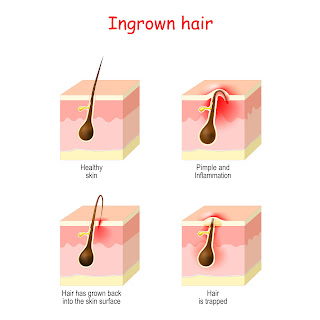What is an ingrown hair?
An ingrown hair is a strand of hair that grows back into your skin after shaving, tweezing or waxing. They may be painful or itchy, and they commonly appear around your face, legs, armpits and pubic area.
Ingrown hairs are sometimes called razor bumps, shave bumps or barber bumps.
Who does ingrown hair affect?
Ingrown hair is very common. Anyone who shaves, tweezes or waxes their hair can develop ingrown hairs. If you shave often, you’re more likely to have ingrown hairs.
You’re also more likely to have ingrown hair if you have skin of color or thick, coarse or curly hair.
How does ingrown hair affect my body?
The beard area of your face (neck, cheeks and chin), legs, armpits and pubic area (bikini line and inner thigh) are most likely to develop ingrown hairs. However, they may also appear on other parts of your body, including your scalp, chest, back, abdomen, inside of your nose (nostril), eyebrows and buttocks (butt).
Symptoms and Causes
What are the symptoms of ingrown hair?
The symptoms of ingrown hair include:
- Skin irritation.
- Small bumps with hairs in the middle on your face and neck (papule).
- Pain.
- Discoloration (red, brown or purple).
- Itching.
If an ingrown hair becomes infected, you may notice the bumps getting bigger and more painful. Pustules occur when there’s pus around the follicles. This infection can lead to scarring.
What causes ingrown hair?
Removing hair by shaving, waxing or tweezing can cause ingrown hairs. New hairs grow from hair follicles under your skin. Shaving, waxing and tweezing only remove hair strands — they don’t remove hair follicles.
When new hair grows, it may curl back and enter your skin. This more commonly occurs if your hair is thick, curly or coarse.
How are ingrown hairs treated?
There are several ways to treat ingrown hairs at home, including:
- Stop shaving and allow the hair to grow.
- Use an electric shaver. Hold it just above the surface of your skin.
- Use depilatory products to remove hair without shaving. Depilatory products dissolve the protein structures of your hair.
- Apply warm compresses to your affected skin for 10 to 15 minutes to open your pores and make it easier for ingrown hairs to release.
If your symptoms don’t improve, your healthcare provider may need to prescribe medications that decrease inflammation and improve infections.
In rare cases, your healthcare provider may use a sterile surgical knife with a thin blade (scalpel) to make a small cut in your affected areas. They’ll squeeze out any pus and use sterile tweezers to remove the ingrown hair.
To prevent scarring or infection, don’t pick at, scratch or pop your ingrown hairs.
How do you remove an ingrown hair?
To remove an ingrown hair, gently exfoliate your skin. Exfoliating your skin removes a dead layer of skin cells and helps release ingrown hairs. Use warm — not hot — water and small, circular motions to wash your affected areas with a washcloth, exfoliating brush or exfoliating gel or scrub.
You can also remove an ingrown hair that has looped or curled back into your skin by gently pulling it out with a sterile needle, pin or tweezers. Apply rubbing alcohol to your surrounding skin to prevent an infection. Then, carefully thread the sterile needle, pin or tweezers through the exposed hair loop. Gently lift the hair loop until one end releases from your skin. Article Source


No comments:
Post a Comment